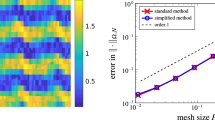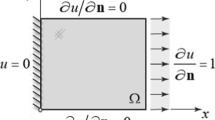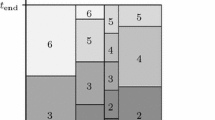Abstract
We construct finite difference discretizations of the acoustic wave equation in complicated geometries and heterogeneous media. Particular emphasis is placed on the accurate treatment of interfaces at which the underlying media parameters have jump discontinuities. Discontinuous media is treated by subdividing the domain into blocks with continuous media. The equation on each block is then discretized with finite difference operators satisfying a summation-by-parts property and patched together via the simultaneous approximation term method. The energy method is used to estimate a semi-norm of the numerical solution in terms of data, showing that the discretization is stable. Numerical experiments in two and three spatial dimensions verifies the accuracy and stability properties of the schemes.











Similar content being viewed by others
References
Appelö, D., Petersson, N.A.: A fourth-order accurate embedded boundary method for the wave equation. SIAM J. Sci. Comput. 34(6), 2982–3008 (2012)
Browning, G., Kreiss, H.-O., Oliger, J.: Mesh refinement. Math. Comput. 27, 29–39 (1973)
Carpenter, M., Gottlieb, D., Abarbanel, S.: Time-stable boundary conditions for finite-difference schemes solving hyperbolic systems: methodology and application to high-order compact schemes. J. Comput. Phys. 111, 220–236 (1994)
Gustafsson, B., Kreiss, H.-O., Oliger, J.: Time Dependent Problems and Difference Methods. Wiley, London (1995)
Henshaw, W.D.: A high-order accurate parallel solver for Maxwellś equations on overlapping grids. SIAM J. Sci. Comput. 5(28), 1730–1765 (2006)
Jensen, F.B., Ferla, C.M.: Numerical solutions of range-dependent benchmark problems in ocean acoustics. J. Acoust. Soc. Am. 87, 1499–1510 (1990)
Jensen, F.B., Kuperman, W.A., Porter, M.B., Schmidt, H.: Computational Ocean Acoustics. Springer, New York (2000)
Knupp, P., Steinberg, S.: Fundamentals of Grid Generation. CRC Press, Boca Raton, FL (1993)
Kreiss, H.-O., Oliger, J.: Comparison of accurate methods for the integration of hyperbolic equations. Tellus 24, 199–215 (1972)
Kreiss, H.-O., Petersson, N.A.: An embedded boundary method for the wave equation with discontinuous coefficients. SIAM J. Sci. Comput. 28(6), 2054–2074 (2006)
Kreiss, H.-O., Petersson, N.A.: A second order accurate embedded boundary method for the wave equation with Dirichlet data. SIAM J. Sci. Comput. 27(4), 1141–1167 (2006)
Kreiss, H.-O., Petersson, N.A., Ystrom, J.: Difference approximations of the Neumann problem for the second order wave equation. SIAM J. Numer. Anal. 42(3), 1292–1323 (2004)
Kreiss, H.-O., Petersson, N.A.: Boundary estimates for the elastic wave equation in almost incompressible materials. SIAM J. Numer. Anal. 50(3), 1556–1580 (2012)
Mattsson, K., Svärd, M., Carpenter, M., Nordström, J.: High order accurate computations for unsteady aeordynamics. Comput. Fluids 36(3), 636–649 (2007)
Mattsson, K.: Summation by parts operators for finite difference approximations of second-derivatives with variable coefficients. J. Sci. Comput. 51(3), 650–682 (2012)
Mattsson, K., Carpenter, M.: Stable and accurate interpolation operators for high-order multiblock finite difference methods. SIAM J. Sci. Comput. 32(4), 2298–2320 (2010)
Mattsson, K., Ham, F., Iccarino, G.: Stable boundary treatment for the wave equation on second order form. J. Sci. Comput. 41(3), 366–383 (2009)
Mattsson, K., Ham, F., Iaccarino, G.: Stable and accurate wave propagation in discontinuous media. J. Comput. Phys. 227(19), 8753–8767 (2008)
Mattsson, K., Nordström, J.: Summation by parts operators for finite difference approximations of second derivatives. J. Comput. Phys. 199(2), 503–540 (2004)
Nissen, A., Kreiss, G., Gerritsen, M.: High order stable finite difference methods for the Schrödinger equation. J. Sci. Comput. 55(1), 173–199 (2013)
Nordström, J., Carpenter, M.H.: High-order finite difference methods, multidimensional linear problems and curvilinear coordinates. J. Comput. Phys. 173(26), 149–174 (2001)
Nordström, J., Gong, J., Wiede, E., Svärd, M.: A stable and high order multi-block method for the compressible Navier–Stokes equations. J. Comput. Phys. 228, 9020–9035 (2009)
Petersson, N.A., Sjögreen, N.: Stable grid refinement and singular source discretization for seismic wave simulations. Commun. Comput. Phys. 8(5), 1074–1110 (2010)
Strand, B.: Summation by parts for finite difference approximations for d/dx. J. Comput. Phys. 110(1), 47–67 (1994)
Sturm, F.: Investigation of 3-D benchmark problems in underwater acoustics: a uniform approach. In: Proceedings of the 9th European Conference on Underwater Acoustics vol. 2, pp. 759–764 (2008)
Sturm, F., Ivansson, S., Jiang, Y., Chapman, N.R.: Numerical investigation of out-of-plane sound propagation in a shallow water experiment. J. Acoust. Soc. Am. 124(6), 341–346 (2008)
Virta, K., Duru, K.: High Order Finite Difference Schemes for the Elastic Wave Equation in Discontinuous Media. Available as preprint arXiv:1309.5768 (2013)
Waldén, J.: On the approximation of singular source terms in differential equations. Numer. Methods Partial Differ. Equ. 15(4), 503–520 (1999)
Whitham, G.B.: Linear and Nonlinear Waves. Wiley, London (1974)
Author information
Authors and Affiliations
Corresponding author
Appendices
Appendix 1: Proof of Lemma 2
The proof of Lemma 2 uses the structure of the \(2p\)-th order accurate narrow diagonal variable coefficient second derivative SBP operator constructed in [15]. For reference the operators \(D_1\) and \(D_2^{(b)}\) for the case \(p = 2\) are formulated explicitly. The norm \(H\) is given by
The 4-th order accurate narrow diagonal first derivative SBP operator \(D_1\) is:
With the lower right \(4 \times 6\) block obtained by rotating the upper left \(4 \times 6\) block \(180^{\circ }\) and changing the signs of the elements. The part \(M^{(b)}\) of the 4-th order accurate narrow diagonal variable coefficient second derivative SBP operator compatible with \(D_1\) is
Where
with
the lower right \(3 \times 6\) block of \(D_3\) is obtained by rotating the upper left \(3 \times 6\) block \(180^{\circ }\) and changing the signs of the elements,
the lower right \(3 \times 6\) block of \(D_4\) is obtained by rotating the upper left \(3 \times 6\) block \(180^{\circ }\). The matrix \(S\) is given by
1.1 Proof of Lemma 2
Let \(l_p\) be an positive integer, \(b_L\) as in the lemma and \(B_L\) the matrix with the only non-zero elements \(B_{L_{i,i}} = b_L,i = 1\dots l_p\). For \(p = 2\) define
By the choice of \(B_L\) these matrices are symmetric positive semi-definite. Now, \(S^{-T} M_L S^{-1} = \varDelta x b_L \tilde{M}_L\). Where \(\tilde{M}_L\) is independent of \(\varDelta x\) and \(b_L\). By the construction of \(B_L\) the only non-zero elements of \(\tilde{M}_L\) are located in an upper left square block \(A\) of size independent of \(\varDelta x\) but dependent on \(l_p\), by construction \(A = A^T \ge 0\). For \(l_p = 1, \dots \) compute \(A\) and construct the matrix \(B\) with \(B_{ij} = A_{ij}, B_{11} = A_{11} - \beta \). \(\beta \) is then chosen by computing the eigenvalues of \(B\) as the largest number such that \(B \ge 0\). Note that also \(\beta \) is independent of \(\varDelta x\). A choice of \(l_p = 4\) gives a value of \(\beta \) as in Table 1. Let \(\bar{M}_L\) be the matrix resulting from subtracting \(\varDelta x b_L \beta \) from the first diagonal element of \(\varDelta x b_L \tilde{M}_L\). We get
Similarly we can derive the second term of (17) by constructing the corresponding \(M_R\) e.t.c., Then taking \(\bar{M}^{(b)} = \tilde{M}^{(b)} + M_L + M_R\) proves the lemma for \(p = 2\). The proof for \(p = 1\) and \(p = 3\) follows the same arguments as for \(p = 2\). \(\square \)
Appendix 2: Dirichlet Boundary Conditions
Assume a homogeneous Dirichlet boundary condition at the west boundary. The corresponding SAT term is then
Similar to the discretization of the interface conditions homogeneous Dirichlet boundary conditions adds a term to the total semi-discrete acoustic energy. The following lemma, proved similarly to Lemma 6, determines the parameter \(\tau _D\) for this term do be positive semi-definite.
Lemma 7
With the same notation as in Lemma 6 and \(\mathbb {1} = \mathrm{diag}(1,\dots ,1)\) the matrix
is positive semi-definite if \(\tau _j \le -\frac{1}{c_{1_j}} - \frac{1}{c_{2_j}}\).
Define
and let
where \(b_ {1R_{j,j}}\) and \(b_ {2R_{j,j}}\) are defined by (25), then the addition of the term \(\mathbf {U}_D^T H_D \mathcal {T}_D(\tau _D,b_{1 R},b_{2 R}) \mathbf {U}_D\) to the total semi-discrete energy also defines a semi norm of the solution to (21) and (22). Now with a Dirichlet boundary condition. An energy estimate in this semi-norm follows as in Theorem 1.
Rights and permissions
About this article
Cite this article
Virta, K., Mattsson, K. Acoustic Wave Propagation in Complicated Geometries and Heterogeneous Media. J Sci Comput 61, 90–118 (2014). https://doi.org/10.1007/s10915-014-9817-1
Received:
Revised:
Accepted:
Published:
Issue Date:
DOI: https://doi.org/10.1007/s10915-014-9817-1




